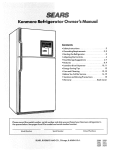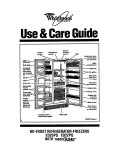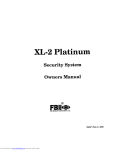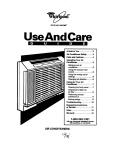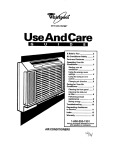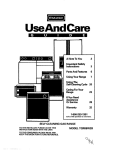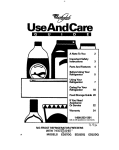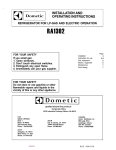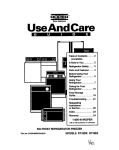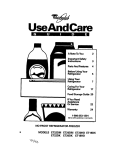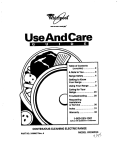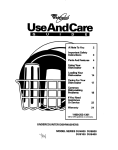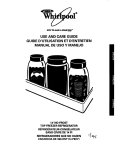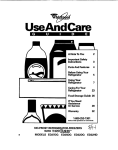Download Whirlpool 3ET16NKXDG00 Refrigerator User Manual
Transcript
NO-FROST REFRIGERATOR-FREEZER B 2170417 Use And Care Guide Id9 I? Table of Contents Page A Note to You ........................................... 2 Important Safety Instructions ................. 3 Parts and Features .................................. 4 Before Uslng Your Refrigerator ............ .6 Using Your Refrigerator .......................... 6 Setting the controls ............................... 6 Changing the control settings.. .............. 9 Removing the drop-in dcor trim pieces.. ........................................... 9 Removing the snapoff door trim ......... 10 Removing the snap& door trivets ..... 10 Adjusting the door bins ....................... 10 Adjusting the utility compartment and tray ............................................... 11 Adjusting the refrigerator shelves.. ...... 11 Adjusting the EZ-Trackm refrigerator shelf .................................. 12 Removing the meat drawer and cover ............................................ 13 Removing the crispers and crisper cover ....................................... 14 Page Adjusting the crisper humidity control ................................................. 15 Adjusting the crisper cover track ......... 16 Adjusting the freezer shelf.. ................. 16 Adjusting the half-width freezer shelf ........................................ 16 Removing the pull-out freezer floor.. ...17 Using the ice cube trays.. .................... 17 Using the optional automatic ice maker ............................................ 16 Removing the base grille.. ................... 19 Changing the light bulbs ..................... 19 Understanding the sounds you may hear ............................................. 20 Saving energy ..................................... 21 Reversing the door swing.. .................. 21 Caring for Your Refrigerator ................. 22 Food Storage Guide .............................. 25 Troubleshootlng .................................... 27 Requesting Servke ................................ 27 Warranty .................................................. 26 A Note to You Thank you for buying a Whirlpool0 appliance. Because your life is getting busier and more complicated, Whirlpool Refrigerators are easy to use, save time, and help you manage your home better. To ensure you enjoy years of troublefree operation, we developed this Use and Care Guide. It contains valuable infomration about how to operate and maintain your appliance properly and safely. Please read it oarefully. Your safety is important to us. This guide contains statements under warning symbol. please pay special attention to thii symbol and follow any instructions given. Here is a brief explanation of the use of the warning symbol. Please record your model’s This symbol will help alert you to such dangers as personal injury, bums, fire, and electrical shook. information. Whenever you call to request service on your appliance, you need to know your complete model number and serial number. You oan find this information on the model and serial number label (see diagram on pages 4-5 for location of label). Please also record the purchase date of your appliance and your dealer’s name, address, and telephone number. Keep this book and the sales slip together Model Number 6eriai Number Purchase Date Dealer Name Dealer Phone in a safe place for future reference. To reduce tiw risk of fire, ebctrkai shock, or injury when using your refrigerator, kiiow these basic precautions: l l Read all instructions before using the refrigerator. Chlid entrapment and suffocation are not problems d the past. Junked or abandoned refrigefators are still dangerous . . . eveniftheywilf~ustsitinthegaragea few day~.~ if you are getting rid of your old refrigeratar, do it safely. Please read the enclosed safety booklet from the Association of Home Appfiince Manufacturers. Help prevent accidents. Never allow children to operate, play with, or crawl inside the refrigerator. l Never cban refrigerator psrts with fiammabie fluids. The fumss can create a firs hazard or expkdon. l FOR YOUR SAFETY l DO NOT STORE OR USE GASOLINE OR OTHER FLAMMABLE VAPORS AND LIQUIDS IN THE ViCiNtTY OF THIS OR ANY OTHER APPLIANCE. THE FUMES CAN CREATE A FIRE HAZARD OR EXPLOSION. l - SAVE THESE INSTRUCTtONS - Help us help you Please: l install and level the refrigerator on a floor that will hokf the weight and ln an area suitable for its size and use. l Do not install the refrigerator near an oven, radiittx, or other heat source. l Do not use the refrigerator in an area where the r-m temperature will fall below 13% (55°F). l Keep the refrigerator out of the weather. l Connect the refrigerator only to the proper kind of outlet, with the correct electriil supply and grounding. l Do not load the refrigerator with food before it has time to get properly cold. l Use the refrigerator only for the uses descrbed ln this manual. l Properfy maintain the refrigerator. l Be sure the refrigerator is not used by anyone unable to operate it properly. 3 Parts and Features This section contains captioned illustrations of your appliance. Use them to become familiar with where all parts and features are located and what they look like. Control panels STYLE 1 Refrl&ator control STYLE 2 Freezer ahelf Control oanel H Modal and sertal number label (on side wall) 4 i ii- F&or control doortrim - Utility compartment ,Ew I bin Adjuetebie Wh * rhdvea 7llll~ II I III Snwn door trim II 1” c I1111 ..a. Base grille base grille) ke cube traya and h -1111 I Freezer light haif-width EZ-TrackW Model and l erial Before Using Your Refrigerator It is important to prepare your refrigerator for use. This section tells you how to clean it, connect it to a power source, install it, and level it. Cleaning Removing your packaging refrigerator materials Remove tape and any inside labels (except the model and serial number label) before using the refrigerator. To remove any remaining glue: Rub briskfy with thumb to make a ball, then remove. OR l Soak area with liquid handdishwashing detergent before removing glue as described above. Do not use sharp instruments, rubbing alcohol, flammable fluids, or abras’nre cleaners. These can damage the material. See “Important Safety Instructions” on page 3. l Plugging NOTE: Do not remove any permanent instruction labels inside your refrigerator. Do not remove the Tech Sheet fastened under the refrigerator at the front. Cleaning it before use After removing all packaging materials, clean your refrigerator before using it, if necessary. See cleaning instructions on pages22-23. it in Recommended Groundlng Method A 115 Volt/Go Hz (Plug l), 220/240 Volt/50 Hz (Plug 2) or 220 Volt60 Hz (Plug 3) AC only 15 or 20 arnpere fused and properly grounded electrical supply is required. It is recommended that a separate circuit serving only this appliance be provided. Use a receptacle which cannot be turned off with a switch or pull chain. Do not use an extension cord. Plug 2 Plug 1 Plug 3 6 Installing it properly Allow 1.25 cm (lh inch) space on each side and at the top of the refrigerator for ease of installation. 2. If the hinge side of the refrigerator is to be against a wall, you might want to leave extra space so the door can be opened wider. 3. The refrigerator can be flush against the back wall. 1. Leveling it Your refrigerator has 2 front leveling screws - one on the right and one on the left. To adjust one or both of these, follow the directions below. 1. Remove base grille. (See page 19.) 2. To raise front, turn screw clockwise. 3. To lower front, turn screw counterclockwise. 4. Check with level. 5. Replace base grille. (See page 19.) Right to 7 Using Your Refrigerator To obtain the best possible results from your refrigerator, it is important that you operate it property. This section tells you how to set the controls, remove and adjust the features in your refrigerator, and how to save energy. Setting the controls Controls for the refrigerator and freezer are in the refrigerator. When you plug in the refrigerator for the first time: 1. Set the Refrigerator Control to 3 (Recommended Setting). Refrigerator Control settings range from 1 (warmest) to 5 (coldest). 2. Set the Freezer Control to 3 (Recommended Setting). Freezer Control settings range from 1 (warmest) to 5 (coldest). 3. Give the refrigerator time to cool down completely before adding food. This may take several hours. The settings indicated above should be correct for normal, household refrigerator usage. The controls are set correctly when milk or juice is as cold as you like and when Ice cream is firm. If you need to adjust these settings, see “Changing the control settings” on page 9. STYLE 1 STYLE 2 Changing the control If you need to adjust temperatures in refrigerator or freezer, use the settings listed in the chart below as a guide. CONDlTION: Refrigerator section too warm Freezer section too warm Refrigerator section too cold Ice not made fast enough Both sections too warm Removing (on some settings l l l Adjust the Refrigerator Control first. Wail at least 24 hours between adjustments. Then adjust the Freezer Control if needed. RECOMMENDED CONTROL SETTINGS: Freezer Refrigerator REASON: Door opened often Large amount of food added Room temperature too warm 4 2 Door opened often Large amount of food added aVery cold room temperature (can’t cycle often enough) 3 4 2 4 Heavy be usage Very cold raom temperature (can’t cycle often enough) 4 4 Door opened often Large amount of food added every warm or very cold room teqeratures 4 l l l l l l l l Controls not set correctly for your conditions l 4 l the drop-in door trim pieces models) To remove the trim place: 1. Remove all items from the shelf. 2. Pull straight up on the trim piece at each end. To replace the trim piece: 1. Locate each end of the trim piece above the trim pocket opening. 2. Push the trim piece straight down until it stops. 3. Replace items on the shelf. 9 Removing the snap-off door trim To remove the trim piece: 1. Remove all items from the shelf. 2. Pull out on the inside tab at each end of the trim piece. 3. Lift trim piece straight out. To replace the trlm piece: 1. Line up ends of the trim piece with the button on the door liner wall. 2. Push trim piece straight back until it snaps securely into place. 3. Replace items on the shelf. Removing (on some the snap-off door trivets models) To remove the trivet: 1. Remove all items from the shelf. 2. Pull out on the inside tab at each end of the trivet. 3. Lii trivet straight out. To replace the trivet: 1. Line up ends of trivet with the button on the door liner wall. 2. Push trivet straight back until it snaps securely into place. 3. Replace items on the shelf. Adjusting the door bins To remove door blns: 1. Lii bin up. 2. Pull bin straight out. To replace door bins: 1. Slide bin in above desired support button. 2. Push down until it stops. 10 (on some models) Adjusting (on some the utility compartment and tray models) The utility compfutment and tray slide from one side-to the other for more flexible storage. The tray fits on either side of the utility comrtment or partially underneath ft. Experiment and find the positiins that work best for you. To adjust the utility compartment or tray: 1. Lift the front slightly. 2. Slide to desired position. 3. Lower front to lock into place. Adjusting the refrigerator shelves Adjust-the shelvesto match the way you use your refrigerator. Glass shelves are strong enough to hold bottles, milk, and other heavy food items. Cantilever shelves To remove a shelf: 1. Remove items from shelf. 2. Tilt shelf up at front. 3. Lii shelf at back. 4. Pull sheff straight out. To replace a shek 1. Guide the rear shelf hooks into the slots in the shelf supports on the back liner wall. 2. Tilt front of shelf up until hooks drop into slots. 3. Lower front of shelf to a level position. Slide-out STYLE 1 NOTE: Glass shelves are heavy. Handle them carefully . shelves To remove the shelves: 1. Remove all items from the shelf. 2. Slide shelf straight out to the stop. 3. Lii the front slightly. 4. Slide shelf out the rest of the way. To replace the shelves: 1. Fit back of shelf on top of guide with wire stops on the bottom of the guide. 2. Lii the front. 3. Slide shelf in until it clears all stops. 11 STYLE 2 11 Adjusting (on some the EZ-Trackm refrigerator shelf models) The U-Track shelf slide from side to side for more flexible storage in your refrigerator. To slide shelf sld+tmMe: 1. Lii slightly on shelf front. 2. Slide to desired bcatbn. 3. Lower shelf front to level position. NOTE: You do not have to remove small items from the shelf before moving it side-toside. You may need to remove larger items. then slide to new location. Umer To remove the shelf: 1. Remove all items from the shelf. 2. Hold back of shelf with one hand. 3. Lii front of shelf to 45” angle. 4. Lower shelf slightly to release shelf from upper channel of track Then pull shelf straight out. channel HoM wtth both hands and lift front to 45’ angle. NOTE: Shelf is heavy. Make sure you use both hands when removing shelf. To remove shelf track: 1. Lii both sides of track slightly. 2. Pull track straight out. Hold both sides and lift up and out To replace shelf track: 1. Guide track hooks into the shelf support slots on the back wall of the cabinet. NOTE: Make sure all three track hooks are in slots and that the slots are parallel to each other. 2. Push track backward and down. 3. Check that track is completely seated in the shelf supports. 12 Make sure both sets of hooks are in suppoRt slots. \ Shetf support Upper channel f track To r&stall shelf~ 1. Hold shelf at front and hack. 2. Till front of shelf up to a 45” angle to track. 3. Insert both rear shelf slides into upper channel of track. 4. Lower front of shelf to a level position. NOTE: Make sure both rear shelf slides are securefy in the track before letting go of shelf. Removing Style lnrert rear shett s Into upper channel of track. the meat drawer and cover 1 To remove the meat drawer: 1. Slide meat drawer out to the stop. 2. Lii front of meat drawer and slide meat drawer out the rest of the way. 3. Replace in reverse order. STYLE 1 To adjust the cover positIon: 1. lilt front of cover up. 2. Lll hack of cover. 3. Pull cover straight out. To replace the cover: 1. Guide the cover’s rear hooks into the slots in the sheff supports on cabinet wall. 2. Tilt cover up at front until the hooks drop into slots. 3. Lower front of cover to a level position. 13 Style 2 Remove the meat drawer and cover for easier cleaning. To remove the meat drawer: 1. Slide meat drawer out to the stop. 2. Lii the front of the meat drawer. 3. Slide meat drawer out the rest of the way. 4. Replace in reverse order. To remove the cover: 1. Remove meat drawer. 2. Push cover hack to release the rear of the cover from the shelf. 3. lilt cover up at the front. 4. Pull cover forward and out. STYLE 2 Remove meat drawer before cover. and crisper cover To replace the cover: 1. Ffl notches and rear edge of cover over rear and center crossbars on the shelf. 2. Lower cover into place. 3. Replace the meat drawer. Removing the crispers For your convenience, one crisper is slightly larger than the other. Thii allows you to store celery and other longer items in your crisper. 1 hJ To remove the crispers: 1. Slide crisper straight out to the stop. 2. Lift the front. 3. Sliie oul the rest of the way. 4. Replace in reverse order. To remove the cover: 1. Push up the cover insert from the bottom, then slide out with both hands. 2. Lii front of cover frame. 3. Lii cover frame up and out. Remove the cover Insert. Llft the cover front, then the back To replace the cover: 1. Pit hack of cover frame into notch sup ports on hack wall of refrigerator, then lower the front into place. 2. Sliie hack of cover insert into place, then lower the front. NOTE: lf cover lnrert I8 glam, handle lt wlth care. It could be heevy. 14 Ilk I Pulloutto the stop, lift the front, and pull again. Adjusting the crisper humidity control You can control the amount of humidity in the moisture-sealed crispers. Adjust the control to any setting between LOW and HIGH. l LOW (open) lets moist air out of the crisper for best storage of fruits and vegetables with skins. l HIGH (dosed) keeps moist air in the crisper for best storage of fresh, leafy vegetables. Adjusting the crisper cover track Because your crispers are not the same size, your crisper cover has an adjustable center track so you can switch positions of the crispers. You can adjust the center track with the cover in the refrigerator by removing the crispers and the cover insert. To remove the center track: 1. Push up the cover insert from the bottom, then slide out with both hands. 2. Gently pull up on front end of track. 3. Pull rear end of track out of opening in cover. To replace the center track: 1. Insert rear end of track (with hole) into opening in cover. 2. Lower front end of track into slot. 3. Make sure rear end of track has snapped into place on under side of cover. 15 Adjusting the freezer shelf Adjust the freezer shelf to match the way you use your freezer. To remove the shelf: 1. Lii entire shelf slightly. 2. Move shelf all the way to one side. 3. Tilt other side up and out of shelf support cups. 4. Pull shelf up and out. To replace the shelf: 1. Tilt the sheff and insert into freezer compartment. 2. Insert one end of the shelf all the way into the center of the shelf support cups. 3. Lower other end of shelf and insert into the shelf support cups. 4. Lower shelf into place. NOTE: The shelf should lower slightly and lock into place. If the shelf does not appear sturdy, make sure both ends of the shelf are inserted into the shetf support cups. Adjusting (on some the half-width models) Adjust the shelf according to the space you need in your freezer. Use the bottom position when you don’t need the shelf at all. To adjust the shelf: 1. Remove items from the shelf. 2. Lii shelf up at front. 3. Pull shelf out to the stop. 4. Lii back of shelf. 5. Pull shelf out the rest of the way. To replace the shelf: 1. Guide rear of shelf into desired guide. 2. Lii rear of shelf over stop. 3. Slide shelf in all the way. 4. Lower front into place. 16 freezer shelf Removing (on some the pull-out freezer floor models) The freezer floor pulls out for easier access to foods in the back of the freezer and for easier cleaning. To remove the freezer floor: 1. Lii both back “fences” up and out. 2. Pull floor out about 1 inch (2.5 cm) with one hand around the air tower section (center back) and one hand at center front. 3. Lii floor up at rear until hooks release from cabinet. 4. Pull floor out the rest of the way. To replace the freezer floor: 1. Position back of floor into freezer opening. 2. Slide floor straight in until hooks drop into place at rear of cabinet. 3. Replace “fences” by aligning pins with sockets in the floor. Push down until they snap into place. Using the ice cube trays If cubes are not used, they may shrink. The moving cold air starts a slow evaporation. The longer you store cubes, the smaller they get. To remove Ice: 1. Hold tray at both ends. 2. Twist slightly. 17 Using the optional automatic If your refrigerator has an automatic ice maker, or if you plan to add one later (contact the dealer for ice maker kit number), here are a few things you should know. l The ON/OFF lever is a wire signal arm. DOWN to make ice automatically UP to shut off the ice maker IMPORTANT: Do not turn ice maker on until you connect it to the water suppfy. l If you remove the ice bin, raise the signal arm to shut off the ice maker. When you replace the bin, push it in all the way and lower the ice maker signal arm to the ON position. l Good water quality is important for good ice quality. Try to avoid connecting the ice maker to a softened water supply. Water softener chemicals (such as salt from a maffunctioning softener) can damage the ice maker rnokl and lead to poor ice qualii. lf you cannot avoid a softened water supply, make sure the water softener is operating property and is well maintained. Solving common PROBLEM Ice crescents attached at corners Ice maker will not operate or Ice Is not made fast enough Off-taste or odor In ke ice maker UP to atop ke mnker. DOWN to start ke maker. problems POSSIBLE CAUSE/SOLUTlON l This is normal. They break apart easily. Shake bin occasionally to keep cubes separated. l l l l l l 18 ice maker ON/OFF lever is in the OFF (up) position. Lower lever to the ON (down) position. Freezer is not cold enough. Adjust temperature controls and wait 24 hours. (See “Changing the control settings” on page 9.) New plumbing connections can cause discolored or offflavored ice. Discard the first few batches of ice. Cubes are stored too long. Throw them away and make a new supply. Food is not wrapped properly. See page 25. Freezer and ice bin need to be cleaned. See page 22. Removing the base grille Condenser To remove the base grllb: 1. Open the refrigerator door. 2. Grasp the grille with both hands. 3. Push down on the top edge of the grille to release the top clips. 4. Roll grille toward you to release top dips. 5. Pull grille away from the refrigerator. D&o81 NOTE: DC not remove the Tech Sheet fastened behind the grille. To replace the base gtllle: 1. Line up the edges of the grille with the outside edges of the cabinet. 2. Roll the grille toward you. 3. Place the lower clips in the openings in the metal panel. 4. Roll the grille toward the cabinet until the top dips snap into place. 5. Close the refrigerator door. Cilpr See cleaning instructions for defrost pan and condenser coils on page 23. Changing the light bulbs STYLE 1 L Electrical Shock Hazard Before removing a light bulb or removing a light shield for cleaning, either unplug the refrigerator or disconnect the electricity leading to it at the main power WP~. Failure to do so could rwuft in electrical shock. J To change refrigerator light: 1. Disconnect refrigerator from power WPly . 2. Reach behind Control Panel to remove bulb. 3. Replace with a 40-watt appliance bulb. 4. Reconnect refrigerator to power suppfy. 19 To change freezer IlgM: 1. Disconnect refrigerator from power supply. 2. Reach behind light shield to bulb. 3. Replace bulb with a 40-watt appliance bulb. 4. Reconnect refrigerator to power supply. NOTE: Not all appliance bulbs will fit your refrigerator. Be sure to replace a bulb with one of the same size and shape. Understanding the sounds Your new refrigerator may make sounds that your old one didn’t. Because the sounds are new to you, you might be wncemed about them. Don’t be. Most of the new sounds are normal. Hard surfaces like the floor, walls, and cabinets can make the sounds seem louder. The following describes the kinds of sounds that might be new to you, and what may be making them. Water hum, soft hiss sounds When the refrfgerator stops running, you may hear gurgling in the tubing for a few minutw after it stops. You may also hear defrost water running into the defrost water pan. Ice maker l l Slight you may hear sounds trickling water thud (clatter of ice) You may hear the refrigerator’s fan motor and moving air. You may hear buzzing (from the water vafve), trickling water, and the clatter of ice dumped into the bin. Clicking Running or snapping sounds The thermostat makes a definite click when the refrigerator stops running. It also makes a sound when the refrigerator starts. The defrost timer will click when the defrost cycle starts. 20 sounds Your refrigerator has a high-efficiency compressor and motor. It will run longer than older designs. It may even seem to run most of the time. Saving energy You can help your refrigerator use less electricity. l Check door gaskets for a tight seal. Level the cabinet to be sure of a good seal. l Clean the condenser coils regularly. l Open the door as few times as possible. Think about what you need before you open the door. Get everything out at one time. Keep food organized so you won’t have to search for what you want. Close door as soon as food is removed. Reversing l l l Go ahead and fill up the refrigerator, but don’t overcrowd it so air movement is blocked. It is a waste of electricii to set the refrigerator and freezer to temperatures colder than they need to be. If ice cream is firm in the freezer and drinks are as wkl as your family likes them, that’s cold enough. Make sure your refrigerator is not next to a heat source such as a range, water heater, furnace, radiator, or in direct sunlight. the door swing The doors on your refrigerator are reversible. If you need to reverse the door swing, refer to the instruction sheet included with your refrigerator. 21 Caring for Your Refrigerator Your refrigerator is built to give you many ywrs of dependable wrvice. However, there are a few things you can do to help extend its product lie. Thii section tells you how to clean your refrigerator and what to do when going on holiday, moving, or during a power outage. Cleaning your refrigerator Roth the refrigerator and freezer sections defrost automatically. However, clean both ahout once a month to prevent odors from building up. wipe up spills right away. To clean your refrigerator, unplug it, take out all removable parts, and clean the refrigerator according to the following directions. PART WHAT TO USE Removable parts (shelves, crisper, etc.) Sponge or cloth with mild detergent and warm water Outslde Sponge, cloth, or paper towel with mild detergent, warm water, and an appiiince wax (or good auto paste wax) Inside walls (allow freezer to warm up so cloth won’t stick) Sponge, soft cloth, or paper towel with baking soda or mikl detergent and warm water Personal Injury Hazard Refrigeration system tubes are near the defrost pan and can hecome hot. Remove and install defrost pan carefully. Failure to do so could result in personal HOW TO CLEAN l l l l l l 22 Hand wash, rinse, and dry thoroughly. Wash outside of cabinet. Do not use abrasive or harsh cleaners. Rinse and dry thoroughly. Wax painted metal surfaces at least twice a year. Apply wax with a clean, soft cloth. Waxlng painted metal surfaces provkles rust protection. Do not wax Plastic parts. Wash with mixture of warm water and -mild detergent, or -baking soda (26 g (2 tablespoons] to .g5 L [l quart] of water). Rinse and dry thoroughly. PART Door liners and gaskets WHAT TO USE Sponge, soft cloth, or paper towel with mild detergent and warm water HOW TO CLEAN Wash, rinse, and dry thoroughfy. DO NOT USE cleaning waxes, concentrated detergents, bleaches, or cleaners contalnlng petroleum on plastic parts. Plastic parts (covers and panels) Soft, clean sponge or soft, clean cloth with mild detergent and warm water Wash, rinse, and dry thoroughly. DO NOT USE paper towels, window sprays, scouting cleansers, or flammable flukls. These can scratch or damage material. Ses ‘Important Safety Instructlons” on page 3. Defrost pan Sponge or cloth with mild detergent and warm water l l l l l l l Condenser coils Vacuum cleaner with extended narrow attachment l l l Floor under refrigerator floor cleaners l l l l Holiday Short and moving Remove base grille. (SW page lg.) Reach into small opening at right edge and remove the defrost pan. Wash, rinse, and dry thoroughly. Replace defrost pan. Make sure to push it completely into the opening. Replace base grille. Remove base grille. Vacuum coils when dusty or dirty. Coils may need to he cleaned as often as every other month. Replace base grille. Roll refrigerator out onfy as far as the water supply line allows. Clean floor. Roll refrigerator hack into place. Check to see if the refrigerator is level. care holidays No need to shut off the refrigerator if you will he away for less than four weeks. 1. Use up any perishahles. 2. Freeze other items. 23 Long holidays If you will be gone a month or more: 1. Remove all food from the refrigerator. 2. If your refrigerator has an automatic be maker: l Turn off the water supply to the ice maker at lwst one day ahead of time. l When the last load of ice drops, turn off the ice maker. Make sure all ice is dispensed out of the ice maker mechanism. 3. Unplug the refrigerator. 4. Clean it, rinse well, and dry. 5. Tape rubber or wood blocks to the tops of both doors to prop them open far enough for air to get in. Thii stops odor and mold from building up. Personal Injury Hazard Do not allow children to dimb on, play nwr or climb inside the refrigerator when the doors are blocked open. They may become injured or trapped. Moving When you are moving the refrigerator to a new home: 1. If your refrigerator has an automatic be maker: l Turn off the water supply to the ice maker at least one day ahead of time. l Disconnect the water line. l After the last toad of ice drops, lift the signal arm to the OFF (up) positiin. 2. Remove all food from the refrigerator. 3. Pack all frozen food in dry ice. 4. Unplug the refrigerator. 5. Clean it thoroughly. Rinse well and dry. 6. Take out all removable parts, wrap them well, and tape them together so they don’t shift and rattle. 7. Screw in the leveling rollers. 6. Tape the doors shut and tape the power supply cord to the cabinet. When you get to your new home, put everything back and refer to page 5. Also, remember to reconnect the water supply line. To restart refrigerator, SW “Using Your Refrigerator” on page 8. Power interruptions If electricity goes off, call the power wmparry. Ask how long power will be off. 1. If service will be interrupted 24 hours or less, keep both doors closed. This helps foods stay frozen. 2. If service will be interrupted longer than 24 hours: (a) Remove all frozen food and store in a frozen food locker. OR (b) Place 32 grams of dry ice in freezer for every cubic liter (2 lbs. for every cubic foot) of freezer space. This will keep food frozen for 2 to 4 days. Wear gloves to protect your hands from dry ice bums. 24 OR (c) If neither a food locker or dry ice is available, use or can perishable food at once. 3. A full freezer stays cold longer than a partfy filled one. A freezer full of meat stays wfd longer than a freezer full of baked goods. ff food contains ice crystals, II may be safely refrozen, although the qualii and flavor may be affected. If the condition of the food is poor, or if you feel it is unsafe, dispose of it. Food Storage Guide There is a correct way to package and store refrigerated or frozen food. To keep food fresher, longer, take the time to study these recommended steps. Storing fresh food Wrap or store food in the refrigerator in airtight and moisture-proof material. This prevents food odor and taste transfer throughout the refrigerator. For dated products, check code date to ensure freshness. Leafy vegetables Remove store wrapping and trim or tear off bruised and discolored arws. Wash in cold water and drain. Place in plastic hag or plastic container and store in crisper. Vegetables with skins (carrots, peppers) Store in crisper, plastic hags, or plastic container. Fruit Cheese Store in the original wrapping until you are ready to use it. Once opened, rewrap tightly in plastic wrap or aluminum foil. Leftovers Cover leftovers with plastic wrap or aluminum foil. Plastic containers with tight lids can also he used. Meat Store most meat in original wrapping as long as it is airtight and moisture-proof. Rewrap if necessary. SW the following chart for storage times. I TYPE APPROXIMATE TIME (DAYS)+ I Wash, let dry, and store in refrigerator in plastic hags or crisper. Do not wash or hull berries until they are ready to use. Sort and keep berries in their original container in a crisper, or store in a loosely closed paper hag on a refrigerator shelf. Store without washing in the original carton on interior shetf. Milk Wipe milk cartons. For best storage, place milk on interior shelf. Butter t When storing meat longer than the times given, follow the directions for freezing. NOTE: Use fresh fish and shellfish the same day as purchased. or margarine Keep opened butter in covered dish or closed compartment. When storing an extra supply, wrap in freezer packaging and freeze. 25 Storing frozen food The freezer section is designed for storage of commercially frozen food and for freezing food at home. NOTE: For further information about preparing food for freezing or food storage times, check a freezer guide or reliable cookbook. Packaging The secret of successful freezing is in the packaging. The way you close and seal the package must not allow air or moisture in or out. Packaging done in any other way could cause food odor and taste transfer throughout the refrigerator and drying of frozen food. PackagIng recommended for use: l Rigid plastic containers with tight-fitting lids l Straight-sided canning/freezing jars l Heavy-duty aluminum foil l Plastic-coated paper l Non-permeable plastic wraps (made from a Saran film) Follow package or container instructions for proper freezing methods. Do not uw: Bread wrappers l Non-polyethylene plastic wntainers l Containers without tight lids l Waxed paper l Wax-coated freezer wrap l Thin, semi-permeable wrap The uw of these wrappings could cause food odor, taste transfer, and drying of frozen food. l 26 Freezing Do not expect your freezer to quick-freeze any large quantity of food. Put no more unfrozen food into the freezer than will freeze within 24 hours (no more than 32 to 48 grams of food per liter [2 to 3 Ibs. per cubic foot] of freezer space). Leave enough space for air to circulate around packages. Be careful to leave enough room at the front so the door can close tightly. Storage times will vary according to the quality of the food, the type of packaging or wrap used (airtight and moistureproof), and the storage temperature, which should be -17.8% (0°F). Troubleshooting Lied in this chart are the most wmmon problems consumers run into with their appliances. Please read through this and see if it can solve your problem. PROBLEM Your refrlgerator will not operate CHECK ME FOLLOWING Is the power supply cord firmly plugged into a live circuit with proper voltage? Has a household fuse or circuit breaker bbwn/tripped? Is the Refrigerator Control set to the OFF position? The lights do not work Is the power suppfy cord firmly plugged into a live circuit with proper voftage? Has a household fuse or circuit breaker blown/tripped? Is a bulb burned out? You hear unfamlllar sounds or a rattling/ jlngllng noise Some new sounds are normal. See “Understanding the sounds you may hear” on page 20. There Is water In the defrost pan This is normal on hot, muggy days. Make sure the refrigerator is level so the pan does not overflow. The motor seems to nin too much Are the condenser coils dirty? Is something on top of or behind the refrigerator7 Has the door been open often? Has a large amount of food been added at one time? The motor naturally runs longer in these cases. Is the room hot? ff the room is too warm, the motor runs longer to keep the unit cool. Requesting Service roblem is not due to 1. lf the one o P the items listed in Troubleshooting ... Contact the dealer from whom you purchased the unit or an authorized Whirlpool* service wmpany. ‘When asking for help or sewlce: Please provide a detailed description of the problem, your appliance’s complete model and serial numbers, and the purchase date. (SW page 2.) This information will help us respond properly to your request. 2. If you need FSP’ ment parts+ . . . replace- FSP is a registered trademark of Whirlpool Corporation for quality parts. Look for this symbol of quality whenever you need a replacement part for your Whirlpool appliance. FSP replacement parts will fit right and work right because they are made to the same exacting spscifiitions used to build every new Whirlpool appliance. To locate FSP replacement parts in your area, contact the dealer from whom you purchased the unit or an authorized Whirlpool service company. 27 WHIRLPOOL* Refrigerator Warranty LENGTH OF WARRANM WHIRLPOOL WILL PAY FOR FULL ONE-YEAR WARRANTY From Date of Purchase FSP’ replacement parts and repair labor to correct defects in materials or workmanship. Service must be provided by an authorized Whirlpool service company. FULL FIVE-YEAR WARRANTY From Date of Purchase FSP replacement parts and repair labor to correct defects in materials or workmanship in the sealed refrigeration system. These parts are: 4. Drier 1. Compressor 5. Connecting tubing 2. Evaporator 3. Condenser Service must be provided by an authorized Whirlpool service company. WHIRLPOOL WILL NOT PAY FOR A. Service calls to: 1. Correct the installation of your refrigerator. 2. Instruct you how to use your refrigerator. 3. Replace house fuses or correct house wiring or plumbing. 4. Replace light bulbs. B. Repairs when your refrigerator is used in other than normal, single-family household use. C. Pickup and delivery, Your refrigerator is designed to be repaired in the home. D. Damage to your refrigerator caused by accident, misuse, fire, flood, acts of God, or use of products not approved by Whirlpool. E. Any food loss due to product failure. F. Repairs to parts or systems caused by unauthorized modiiitions made to the appliance. !a33 WHIRLPOOL CORPORATION SHALL NOT BE LIABLE FOR INCIDENTAL OR CONSEQUENTIAL DAMAGES. Outside the United States, a different warranty may apply. For details, please contact your authorized Whirlpool distributor or military exchange. l b@ludTfadsmWWTd WlMpod. USA





























